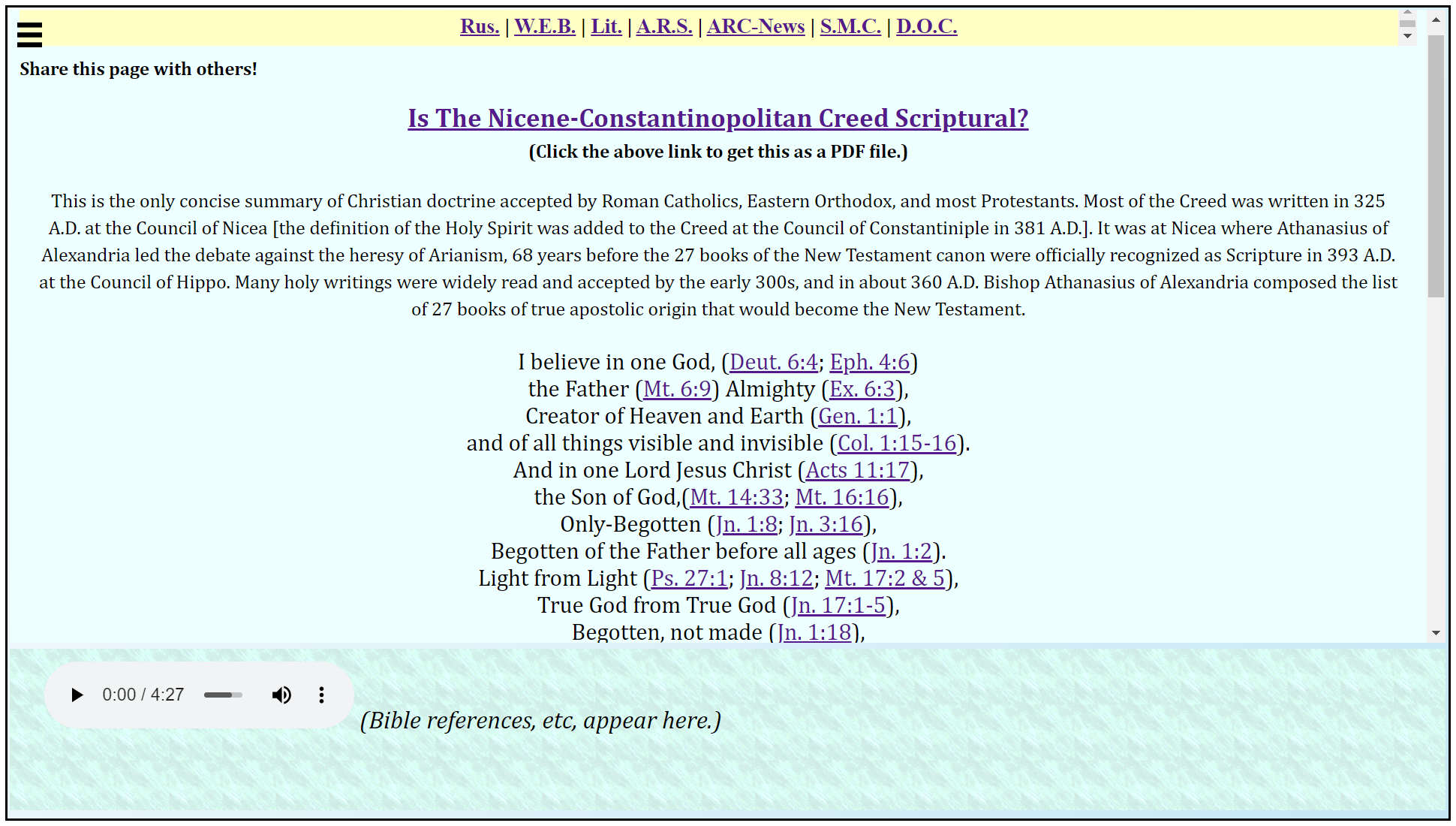Is the Nicene-Constantinopolitan Creed Scriptural?
(Click the photo to get this as a PDF file.) This is the only concise summary of Christian doctrine accepted by Roman Catholics, Eastern Orthodox, and most Protestants. Most of the Creed was written in 325 A.D. at the Council of Nicea [the definition of the Holy Spirit was added to the Creed at the Council of Constantinople in 381 A.D.]. It was at Nicea where Athanasius of Alexandria led the debate against the heresy of Arianism, 68 years before the 27 books of the New Testament canon were officially recognized as Scripture in 393 A.D. at the Council of Hippo. Many holy writings were widely read and accepted by the early 300s, and in about 360 A.D. Bishop Athanasius of Alexandria composed the list of 27 books of true apostolic origin that would become the New Testament.
THE CREED
I believe in one God, (Deut. 6:4; Eph. 4:6)
the Father (Mt. 6:9) Almighty (Ex. 6:3),
Creator of Heaven and Earth (Gen. 1:1),
and of all things visible and invisible (Col. 1:15-16).
And in one Lord Jesus Christ (Acts 11:17),
the Son of God,(Mt. 14:33; Mt. 16:16),
Only-Begotten (Jn. 1:8; Jn. 3:16),
Begotten of the Father before all ages (Jn. 1:2).
Light from Light (Ps. 27:1; Jn. 8:12; Mt. 17:2 & 5),
True God from True God (Jn. 17:1-5),
Begotten, not made (Jn. 1:18),
of one essence with the Father (Jn. 10:30)
through Whom all things were made (Heb. 1:1-2);
Who for us men and for our salvation (1 Tim. 2:4-5)
came down from heaven (Jn. 6:33-35),
and was incarnate of the Holy Spirit and the Virgin Mary (Lk. 1:35)
and became man (Jn. 1:15).
And He was crucified for us (Mk. 15:25; 1 Cor. 15:3)
under Pontius Pilate, (Jn. 19:6) suffered, (Mk. 8:31)
and was buried (Lk. 23:53; 1 Cor. 15:4),
And on the third day He rose again (Lk. 24:1-6),
according to the Scriptures (1 Cor. 15:4),
and ascended into heaven (Lk. 24:51; Acts 1:10),
and sits at the right hand of the Father (Mk. 16:19; Ac. 7:55);
and He shall come again with glory (Mt. 24:27)
to judge the living and the dead; (Acts 10:42; 2 Tim. 4:1)
Whose Kingdom shall have no end (2 Pet. 1:11).
And in the Holy Spirit (Jn. 14:26),
the Lord (Acts 5:3-4) and Giver of Life (Gen. 1:2),
Who proceeds from the Father (Jn. 15:26);
Who with the Father and the Son together is worshiped and glorified (Mt. 3:16-17),
Who spoke through the prophets (1 Sam. 19:20; Ezek. 11:5 & 13).
In one (Mt. 16:18; Eph. 4:1-4) holy (1 Pet. 2:5 & 9),
catholic (Jn. 17:20-23), and Apostolic Church (Ac. 2:42; Eph. 2:19-22).
I acknowledge one baptism for the remission of sins (Ac. 2:38; Eph. 4:5).
I look for the resurrection of the dead (Jn. 11:24; 1 Cor. 15:12-49; Heb. 6:2; Rev. 20:5),
and the life in the world to come. (Mk. 10:29-30)
Amen.

